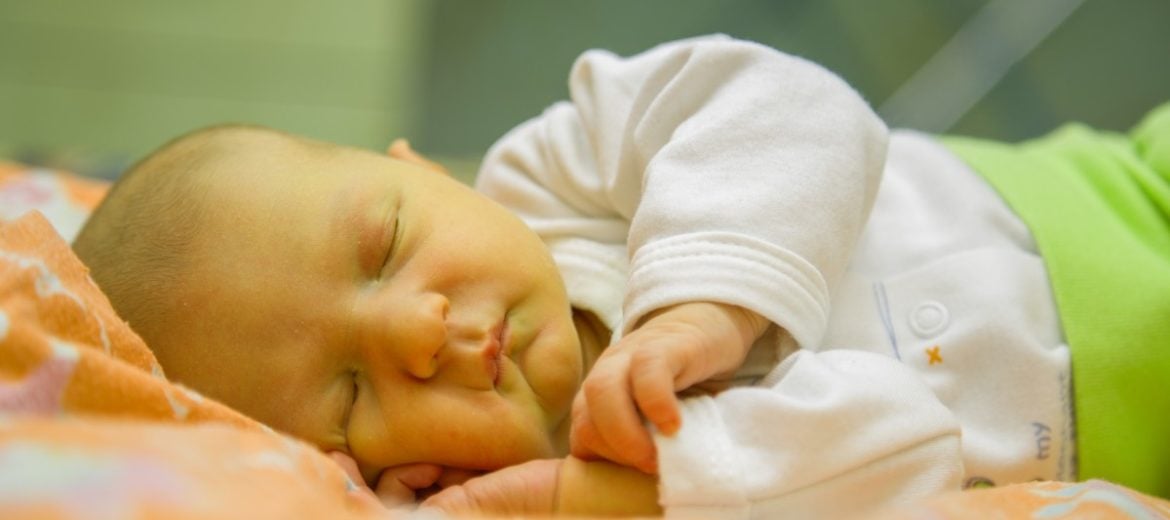Did you know that upto 60-70% of babies are diagnosed with neonatal jaundice? Parents often wonder when to worry when it comes to jaundice in babies.
Lalit and Yamini Kakkar, anxious parents of a 4-day-old newborn, were facing a similar dilemma when their child was diagnosed with jaundice. Their pediatrician referred them to the neonatologist at Sitaram Bhartia Hospital, South Delhi.
The neonatologist proceeded to counsel the worried parents – “You should note that not all babies require treatment as serum bilirubin (yellow pigment) upto a certain limit is normal. Only if the serum bilirubin exceeds a certain value is when action will need to be taken.”
Here are some questions on jaundice in babies Lalit and Yamini asked during their consultations with the doctor.
What causes jaundice in newborns?
Jaundice in babies occurs due to the build-up of a yellow pigment, called bilirubin, in their body. When the baby is still in the womb, the mother’s placenta helps in eliminating the pigment from the baby’s body.
Babies require haemoglobin in the womb to draw oxygen from the mother’s blood. After birth, however, this extra haemoglobin in their blood is broken down into bilirubin and eliminated from the body via the liver.
The infant’s liver, however, is still immature after birth and is often unable to handle and eliminate the bilirubin on its own. This is the reason many newborns develop jaundice after birth.
In most cases, the accumulation of the yellow pigment peaks around the 3rd or 4th day after birth and subsequently starts reducing.
“Is jaundice in my newborn child an indication of an existing or potential liver disease?” asked Lalit, as he put forth his doubts. Lalit’s fears were immediately put to rest when he was reassured that this is a common misconception.
Most babies dealing with jaundice undergo a similar pattern after birth.
Certain diseases or practices, however, may lead to increased chances of jaundice in newborns –
- Inadequate Feeding
If the baby is underfed or not fed properly, he or she may get dehydrated. This will cause the yellow pigment (bilirubin) to build up in the body. - Blood Group Incompatibilities
The jaundice is more likely to be severe in case the baby and the mother have incompatible blood types (babies born to mothers with O blood group or Rh negative blood group are at higher risk).
3. Other Rare Conditions
Certain other rare conditions such as G6DP (glucose 6 phosphate dehydrogenase) deficiency could also be the reason for increased jaundice in babies.
How does jaundice affect a baby?
Some symptoms of jaundice in babies include:
- Yellow-tinged skin, especially around the face and scalp
- A yellow tinge to the white parts of the infant’s eyes
- Darker, yellow urine
- Pale or light-coloured stools
- Feeding difficulties
Can jaundice be harmful for babies?
Jaundice in babies is not fatal, but severe jaundice can lead to potential future complications such as cerebral palsy, hearing loss etc. The jaundice may also leak into the brain and cause permanent damage (by staining the basal ganglia, also called kernicterus).
Jaundice in babies can be harmful if the levels rise to a high value without supervision or proper treatment. Usually this occurs when serum bilirubin is more than 20-25 mg/dl.
Parents should keep in mind, however, that if timely action is taken then jaundice is usually not a cause of worry. You are advised to consult an expert for advice early.
Yamini wanted to know whether their newborn would be able to cope with the condition. She put forth her question.
What level of jaundice is dangerous in newborns?
There is no single value of jaundice pigment (bilirubin) that is universally dangerous. The baby’s tolerance to bilirubin depends on factors such as:
- Baby’s gestation period i.e. whether the baby is preterm or not
- Baby’s weight
- Presence of concomitant features such as blood group incompatibility
- Day of life, as the tolerance differs between the first day of life and fifth day
Using the guidelines laid down by the American Academy of Pediatrics (AAP), neonatologists are able to assess and provide appropriate treatment options tailored to each baby’s need and tolerance levels.
Lalit and Yamini’s newborn was kept under observation for over a week. Unfortunately, his symptoms did not disappear and his parents grew more worried by the day and wanted to know the course of action to treat their baby.
Treatment of Jaundice in Babies
If the bilirubin level is more than the upper tolerance limit for the baby, then phototherapy is recommended which was the case for Lalit and Yamini’s baby.
Phototherapy – what is the treatment for jaundice in a newborn?
Phototherapy, or light therapy, is a treatment option for babies suffering from severe jaundice wherein a process called photo-oxidation and photo-isomerisation lowers the bilirubin levels in baby’s body.
The baby will be placed under a halogen or fluorescent lamp with his or her eyes and genitalia covered. Their skin is thus bleached and the yellow pigment in the body is broken down or lysed, which is then excreted via stool or urine.
Is phototherapy safe?
Yamini wondered if the light therapy could affect her child negatively and wanted to be fully informed before going ahead with it.
Phototherapy, if executed properly, is reasonably safe and does not cause any significant adverse side effects. Due to the precautions taken during the process, the baby’s eyes are not affected by the intense light.
Infants admitted to the NICU for the phototherapy process are usually discharged within 24-48 hours of admission.
Yamini understood that phototherapy is a helpful option for jaundiced newborns, but she still wanted to know whether there were any home remedies she could use in case her child faces discomfort.
How can I treat jaundice at home?
We do not recommend treatment at home for jaundice in babies, but there are certain measures parents can take to prevent occurence of severe jaundice such as:
Breastfeeding, as guided
Lack of proper breastfeeding could aggravate jaundice in babies, which is the reason proper breastfeeding practices should be followed.
Proper exposure to sunlight
Sunlight is also helpful in reducing jaundice. Keep in mind, however, that sunlight is not a cure and the baby will require phototherapy if their condition worsens.
Dietary suggestions
“Are there any diet modifications I need to make?” asked Yamini. She wondered if what she ate could have an effect on her child’s condition.
The doctor helped her understand that according to the current medical literature, there is no effect of the mother’s diet on the baby’s jaundice.
What happens if a baby’s jaundice doesn’t go away?
In most instances, jaundice in babies need not be a cause of worry as the condition resolves within 14 days of being born.
If jaundice is still present beyond 14 days after birth, then it is called persistent or prolonged jaundice in newborn. Your child will undergo certain tests to detect the presence of any diseases that may be causing persistent jaundice, and will be treated accordingly.
The couple felt satisfied now that all their questions had been answered by the neonatologist. Lalit and Yamini were urged to bring their newborn in for a follow-up check up after the light therapy treatment was carried out.
The doctor conducted a thorough review of his condition and noticed the phototherapy session had worked as their child’s skin did not look as yellow any longer. Much to the parents’ relief, the doctor deemed that the newborn was healing rapidly.
If you would like to come in for a consultation with our childcare experts, please call us on +91 8826391002 to book your appointment.

Medically Reviewed by Dr. Neha Joshi
MBBS, Maulana Azad Medical College (2003); MD, Maulana Azad Medical College (2008); MRCPCH, Glasgow, UK in 2011
Experience: 13 Years

